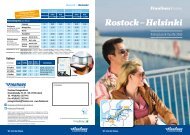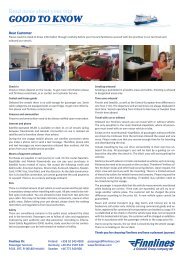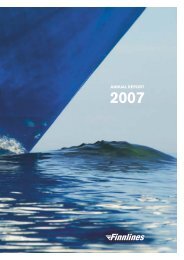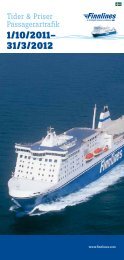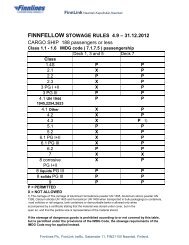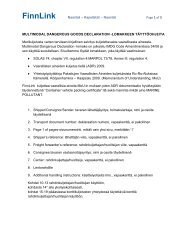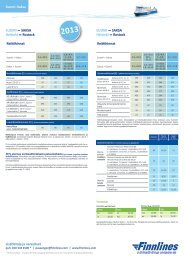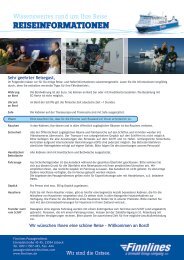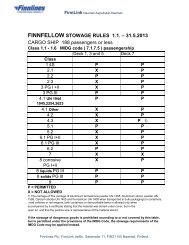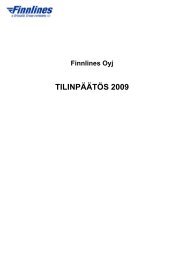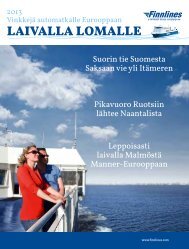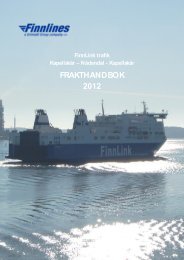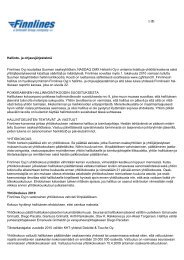FINANCIAL STATEMENTS 2010 - Finnlines
FINANCIAL STATEMENTS 2010 - Finnlines
FINANCIAL STATEMENTS 2010 - Finnlines
Create successful ePaper yourself
Turn your PDF publications into a flip-book with our unique Google optimized e-Paper software.
egory includes assets held for trading as well as assets that were<br />
originally recognised at fair value through profit or loss. The aim<br />
of financial assets held for trading is to produce profits in the<br />
short term (less than 12 months), and they are recognised under<br />
current assets. Derivatives which do not meet the conditions for<br />
hedge accounting are classified as assets held for trading. The<br />
assets in this category are valued at their fair value. Unrealised<br />
and realised profits and losses arising from changes in fair value<br />
are recognised in the profit and loss account in the reporting pe-<br />
riod during which they arise.<br />
Held-to-maturity investments are valued at amortised cost.<br />
During <strong>2010</strong>, the Group has no financial assets to be classified<br />
into this category.<br />
Available-for-sale financial assets are valued at fair value af-<br />
ter their acquisition. Generally the fair value of investments in this<br />
category is determined based on quoted prices published on<br />
the active market, i.e. bid quotations on the balance sheet date.<br />
Unrealised gains and losses arising from valuation at fair value<br />
are recognised in the fair value fund under shareholders' equity.<br />
If financial assets available-for-sale are sold or permanently im-<br />
paired, the cumulative gains and losses are recognised in the<br />
profit and loss account under financial income and expenses.<br />
Available-for-sale financial assets are included in non-current<br />
assets unless the company intends to sell them within the 12<br />
months following the end of the reporting period, in which case<br />
they are included under current assets.<br />
Loans and other receivables are assets whose payments are<br />
fixed or can be reliably determined, and which are not quoted on<br />
the active market or held for trading. This category includes finan-<br />
cial assets that have been acquired by transferring money, goods<br />
or services to a debtor. These items are valued at amortised cost.<br />
Within <strong>Finnlines</strong> these items include accounts receivable and<br />
other receivables, granted loans and fixed-term deposits with a<br />
maturity longer than three months.<br />
Cash and cash equivalents include cash in hand and at bank<br />
as well as other highly liquid assets with a low risk of change of<br />
value and with original maturity at acquisition date of less than<br />
three months.<br />
Financial liabilities<br />
Financial liabilities are initially recognised at the value of the origi-<br />
nal loan amount less direct transaction charges incurred in rela-<br />
tion to the acquisition or issuing of the financial liability item in<br />
question. Later, all financial liabilities are valued at amortised cost<br />
using the effective interest method. Financial liabilities are includ-<br />
ed in both long-term and short-term liabilities and they can be ei-<br />
ther interest-bearing or non-interest-bearing.<br />
Derivatives that do not meet the conditions of hedge account-<br />
ing or for which hedge accounting is not applied are classified as<br />
assets held for trading and are valued at fair value. Negative de-<br />
rivative fair values are recognised under short-term liabilities on<br />
the statement of financial position.<br />
Borrowing costs<br />
(figures in EUR thousand, if not stated otherwise)<br />
Borrowing costs are recognised as expenses for the accounting<br />
period during which they have arisen, except for the borrowing<br />
costs that are directly attributable to the acquisition or construc-<br />
tion of a qualifying asset. The total of the capitalised costs and<br />
the items to which they have been capitalised as acquisition cost<br />
are shown in the notes to 15. Property, plant and equipment.<br />
DERIVATIVES AND HEDGE ACCOUNTING<br />
Derivative contracts are recognised at an acquisition cost that<br />
corresponds to their fair value at the date of acquisition. After ac-<br />
quisition, derivative contracts are measured at fair value, which is<br />
determined on the basis of bid and sales quotations published in<br />
the active market. Gains and losses arising from fair value meas-<br />
urement are recognised based on the purpose of derivative con-<br />
tracts.<br />
Hedge accounting<br />
The Group hedges against risks arising from changes in foreign<br />
currency rates. Such risks include acquisitions of vessels made<br />
partly or fully in a foreign currency. The Group has ordered six ro-<br />
ro vessels from the Chinese Jinling shipyard. These ships will be<br />
paid partly in USD but those instalments have been fully hedged<br />
against changes in the EUR/USD exchange rate. The Group ap-<br />
plies hedge accounting in accordance with IAS 39 to these de-<br />
rivative contracts for the spot part of the forward exchange. It is<br />
considered as hedging of a highly probable cash flow.<br />
At the inception of a hedge relationship, the Group docu-<br />
ments the relationship between the hedging instruments and<br />
hedged item, as well as its risk management objectives and its<br />
strategy for undertaking various hedge transactions. Further-<br />
more, at the inception of the hedge and on an ongoing basis, the<br />
Group documents and evaluates whether the hedging instrument<br />
that is used in a hedging relationship is highly effective in offset-<br />
ting changes in cash flows of the hedged item.<br />
The effective portion of changes in the fair value of derivatives<br />
that are designated and qualify as cash flow hedges is presented<br />
in other comprehensive income and is recorded in the fair value<br />
reserve under shareholders' equity. The gains and losses rec-<br />
ognised in shareholders' equity are transferred to the profit and<br />
loss account for the accounting period in which the hedged item<br />
is recognised in the income statement. The ineffective portion<br />
of the hedge relationship is recognised in financial income or ex-<br />
penses. When the forecast transaction that is hedged results in<br />
the recognition of a non-financial asset or a non-financial liability,<br />
the gains and losses previously deferred in shareholders' equity<br />
are transferred from equity and included in the acquisition cost of<br />
the asset.<br />
The fair values of the derivative instruments used for hedging<br />
purposes are presented in the notes. When the hedging instru-<br />
ment for a cash flow item expires or is sold or no longer quali-<br />
fies for hedge accounting, any cumulative gain or loss deferred<br />
in shareholders’ equity at that time remains in shareholders' eq-<br />
uity until the forecast transaction occurs. However, if the forecast<br />
FINNLINES PLC Financial Statements <strong>2010</strong><br />
15



